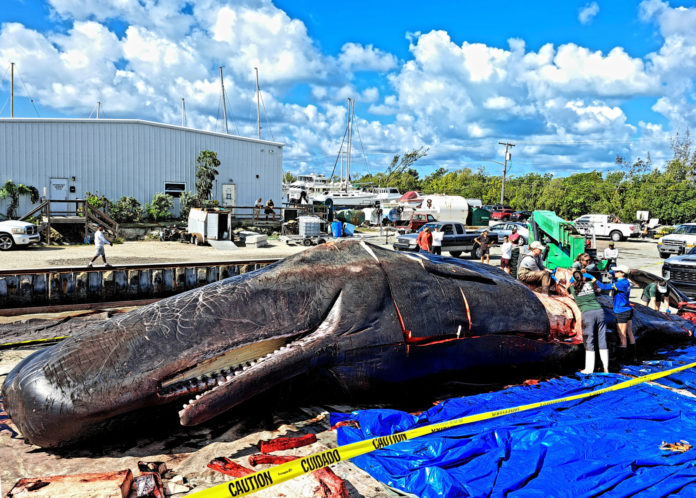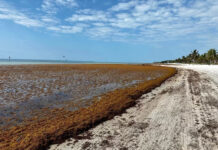
A 51-foot sperm whale was the last thing one expected to see on the morning of May 11, laid out in the gravel parking lot of Robbie’s Marina on Stock Island.
There it was. A striking but sad sight, with a mouth of biblical proportions.
The male sperm whale was found on May 10, beached on the northeast side of the Mud Keys about eight miles offshore of Key West.
“We got a call from the marine sanctuary about it (Tuesday), and went out at high tide last night, around 8:30 p.m. and towed it in, arriving at Robbie’s around 3:30 a.m.,” said Sean Morley, owner of TowboatUS in Key West and Key West Harbor Services. “Fortunately, Robbie’s allowed us to bring it in here so biologists can do their work to determine its cause of death.”
Biologists from Florida Fish & Wildlife Conservation Commission (FWC), and experts from marine mammal stranding groups and the Florida Keys National Marine Sanctuary, quickly got to work, making large incisions in the rough skin of the whale to determine its cause of death through a process called a necropsy, which is similar to an autopsy that’s performed on humans.
“We really won’t know anything further about what happened until later tonight or tomorrow,” FWC officials told the Keys Weekly on the morning of May 11 at the marina, adding that they are looking into unconfirmed reports of a pod of sperm whales possibly being in the area in recent days. Also, last week, a juvenile sperm whale was sighted off the Upper Keys earlier in the week. Investigations continue into any potential correlations, FWC officers said.
Sperm whales are the largest of the toothed whales and have one of the widest global distributions of any marine mammal species, according to the National Oceanic and Atmospheric Administration (NOAA).
“They are found in all deep oceans, from the equator to the edge of the pack ice in the Arctic and Antarctic,” the agency says. “They are named after the waxy substance — spermaceti — found in their heads. The spermaceti is an oil sac that helps the whales focus sound. Spermaceti was used in oil lamps, lubricants and candles.
“Sperm whales were a primary target of the commercial whaling industry from 1800 to 1987, which nearly decimated all sperm whale populations. The International Whaling Commission placed a moratorium on commercial whaling in 1986. The species is still recovering, and its numbers are likely increasing. The sperm whale is listed as endangered under the Endangered Species Act and depleted under the Marine Mammal Protection Act,” states the NOAA Fisheries website.


















